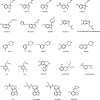Functional characterization of agonists at recombinant human 5-HT2A, 5-HT2B and 5-HT2C receptors in CHO-K1 cells
- PMID:10498829
- PMCID: PMC1571597
- DOI: 10.1038/sj.bjp.0702751
Functional characterization of agonists at recombinant human 5-HT2A, 5-HT2B and 5-HT2C receptors in CHO-K1 cells
Abstract
1. The goal of this study was to characterize the agonist pharmacology of human 5-HT2A, 5-HT2B and 5-HT2C (VSV) receptors expressed in CHO-K1 (Chinese hamster ovary) cells. 2. We used a fluorometric imaging plate reader (FLIPR) which allows rapid detection of rises in intracellular calcium levels upon the addition of agonists. 3. Stimulation of all three receptors by 5-HT caused a robust concentration dependent increase in intracellular calcium levels. No such effect was observed from non-transfected control CHO-K1 cells. 4. The rank order of potency of agonists at the different receptor subtypes varied. Tryptamines, BW-723C86, d-norfenfluramine, Ro 60-0175 and LSD exhibited the following rank order of potency; 5-HT2B>5-HT2C>5-HT2A. Piperazines such as m-Chlorophenylpiperazine (mCPP), ORG-12962, MK-212 and also ORG-37684 exhibited a rank order of potency of 5-HT2C>5-HT2B>5-HT2A. The phenylisopropylamines DOI and DOB had a rank order of 5-HT2A>5-HT2B>5-HT2C. 5. Many agonists tested had partial agonist actions when compared to 5-HT, and a wide range of relative efficacies were exhibited, which was cell line dependent. For example, mCPP had a relative efficacy of 65% at 5-HT2C receptors but <25% at either 5-HT2A or 5-HT2B receptors. 6. Interpretation of literature values of functional assays using different cell lines, different receptor expression levels and different receptor isoforms, is complex. Species differences and the previous use of antagonist radioligands to characterize agonist potency in binding assays emphasizes the importance of studying agonists in the same experiment using the same assay conditions and parental cell lines.
Figures










References
- AKIYOSHI J., NISHIZONO A., YAMADA K., NAGAYAMA H., MIFUNE K., FUJII I. Rapid desensitisation of serotonin 5-HT2C receptor-stimulated intracellular calcium mobilisation in CHO cells transfected with cloned human 5-HT2C receptors. J. Neurochem. 1995;64:2473–2479. - PubMed
- BAXTER G.S. Novel discriminatory ligands for 5-HT2B receptors. Behav. Brain Res. 1996;73:149–152. - PubMed
- BERG K.A., MAAYANI S., GOLDFARB J., SCARAMELLINI C., LEFF P., CLARKE W.P. Effector pathway-dependent relative efficacy at serotonin type 2A and 2C receptors: Evidence for agonist-directed trafficking of receptor stimulus. Mol. Pharmacol. 1998;54:94–104. - PubMed
- BOES M., JENCK F., MARTIN J.R., MOREAU J.-L., SLEIGHT A.J., WICHMANN J., WIDMER U. Novel Agonists of 5HT2C Receptors. Synthesis and biological evaluation of substituted 2-(Indol-1-yl)-1-methylethylamines and 2-(Indeno[1,2-b]pyrrol-1-yl)-1-methylethylamines. Improved therapeutics for obsessive compulsive disorder. J. Med. Chem. 1997;40:2762–2769. - PubMed
Publication types
MeSH terms
Substances
LinkOut - more resources
Full Text Sources
Other Literature Sources
Chemical Information
Molecular Biology Databases
Research Materials
